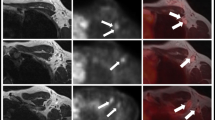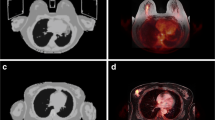Abstract
Goals:18F FDG PET/CT is used for diagnosis, staging and establishing the response to therapy in various malignancies, including breast cancer (BC). Dedicated breast MRI (BMRI) is gaining a role in the management of BC patients (pts), demonstrating high sensitivity and specificity for detection of small lesions. We were therefore prompted to review our experience with PET and BMRI in BC.Methods: This is a retrospective study of 21 women with BC, 30–76 years old, who had BMRI and whole-body FDG PET/CT at our institution from Jun 2002 to May 2005. A total of 6 patients (group A) had BMRI and PET/CT in the preoperative period and 15 patients (group B) had BMRI and PET/CT after surgery. Reinterpretation of the imaging studies for accuracy and data analysis from medical records were performed.Results: For group A, BMRI identified breast lesions in 4 patients, while PET/CT was able to identify breast lesions in 5 patients. All these were proven to be malignancy on pathology examination. In group B, BMRI detected recurrent breast lesions in 8 patients, with 88.9% sensitivity and 83.3% specificity. In the same patient population, PET/CT was 33.3% sensitive and 91.7% specific. As a whole body examination, PET/CT revealed metastatic disease in 6 patients (100% sensitive and 90% specific). Overall, sensitivities and specificities for breast disease detection were 85.7% and 85.7% for BMRI, and 75% and 92.3% for18F FDG PET/CT.Conclusions: As expected, BMRI is more sensitive than PET/CT in the detection of breast lesions. However, PET/CT as a whole-body examination changed the management of disease by detection of distant lesions in 6 of the 21 patients. Our study suggests that18F FDG PET/CT and BMRI should be considered as complimentary imaging tools in the pre- and postoperative workup of patients diagnosed with breast cancer.
Similar content being viewed by others
References
Ries LAG, Eisner MP, Kosary CL, et al (eds). SEER Cancer Statistics Review, 1975–2002, National Cancer Institute. Bethesda, MD, http://seer.cancer.gov/csr/1975_2002/, based on November 2004 SEER data submission, posted to the SEER web site 2005.
Dumitrescu RG, Cotarla I. Understanding breast cancer risk —where do we stand in 2005?.J Cell Mol Med 2005; 9(1): 208–221.
Thurlimann B, Muller A, Senn HJ. Management of primary breast cancer: an update.Onkologie 2004; 27(2): 175–179.
Reddy DH, Mendelson EB. Incorporating new imaging models in breast cancer management.Curr Treat Options Oncol 2005; 6(2): 135–145.
Padhani AR, Ah-See ML, Makris A. MRI in the detection and management of breast cancer.Expert Rev Anticancer Ther 2005; 5(2): 239–252.
Morakkabati-Spitz N, Leutner C, Schild H, Traeber F, Kuhl C, Diagnostic usefulness of segmental and linear enhancement in dynamic breast MRI.Eur Radiol 2005; 15(9): 2010–2017.
Lehman CD, Blume JD, Weatherall P, et al. Screening women at high risk for breast cancer with mammography and magnetic resonance imaging.Cancer 2005; 103(9): 1898–1905.
Hylton N. Magnetic resonance imaging of the breast: opportunities to improve breast cancer management.J Clin Oncol 2005; 23(8): 1678–1684.
Esserman L. Integration of imaging in the management of breast cancer.J Clin Oncol 2005; 23(8): 1601–1602.
Lehman CD, Schnall MD. Imaging in breast cancer: magnetic resonance imaging.Breast Cancer Res 2005; 7(5): 215–219.
Zangheri B, Messa C, Picchio M, et al. PET/CT and breast cancer.Eur J Nucl Med Mol Imaging 2004; 31, Suppl 1: S135–142.
Byrne AM, Hill AD, Skehan SJ, McDermott EW, O'Higgins NJ. Positron emission tomography in the staging and management of breast cancer.Br J Surg 2004; 91(11): 1398–1409.
Isasi CR, Moadel RM, Blaufox MD. A meta-analysis of FDG-PET for the evaluation of breast cancer recurrence and metastases.Breast Cancer Res Treat 2005; 90(2): 105–112.
Buscombe JR, Holloway B, Roche N, Bombardieri E. Position of nuclear medicine modalities in the diagnostic work-up of breast cancer.Q J Nucl Med Mol Imaging 2004; 48(2): 109–118.
Quon A, Gambhir SS. FDG-PET and beyond: molecular breast cancer imaging.J Clin Oncol 2005; 23(8): 1664–1673.
Rieber A, Schirrmeister H, Gabelmann A, et al. Pre-operative staging of invasive breast cancer with MR mammography and/or PET: boon or bunk?.Br J Radiol 2002; 75(898): 789–798.
Hathaway PB, Mankoff DA, Maravilla KR, et al. Value of combined FDG PET and MR imaging in the evaluation of suspected recurrent local-regional breast cancer: preliminary experience.Radiology 1999; 210(3): 807–814.
Offodile RS, Daniel BL, Jeffrey SS, Wapnir I, Dirbas FM, Ikeda DM. Magnetic resonance imaging of suspicious breast masses seen on one mammographic view.Breast J 2004; 10 (5): 416–422.
Wiener JI, Schilling KJ, Adami C, Obuchowski NA. Assessment of suspected breast cancer by MRI: a prospective clinical trial using a combined kinetic and morphologic analysis.AJR Am J Roentgenol 2005; 184(3): 868–877.
Yeh E, Slanetz P, Kopans DB, et al. Prospective comparison of mammography, sonography, and MRI in patients undergoing neoadjuvant chemotherapy for palpable breast cancer.AJR Am J Roentgenol 2005; 184(3): 868–877.
Goerres GW, Michel SC, Fehr MK, et al. Follow-up of women with breast cancer: comparison between MRI and FDG PET.Eur Radiol 2003; 13(7): 1635–1644.
Walter C, Scheidhauer K, Scharl A, et al. Clinical and diagnostic value of preoperative MR mammography and FDG-PET in suspicious breast lesions.Eur Radiol 2003; 13 (7): 1651–1656.
Kumar R, Loving VA, Chauhan A, Zhuang H, Mitchell S, Alavi A. Potential of Dual-Time-Point Imaging to Improve Breast Cancer Diagnosis with18F-FDG PET.J Nucl Med 2005; 46(11): 1819–1824.
Author information
Authors and Affiliations
Corresponding author
Rights and permissions
About this article
Cite this article
Iagaru, A., Masamed, R., Keesara, S. et al. Breast MRI and18F FDG PET/CT in the management of breast cancer. Ann Nucl Med 21, 33–38 (2007). https://doi.org/10.1007/BF03033997
Received:
Revised:
Issue Date:
DOI: https://doi.org/10.1007/BF03033997




